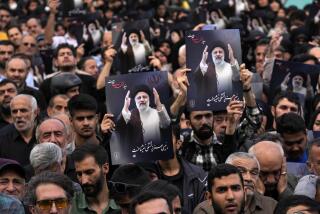Iran Isn’t Only Genesis of Islam’s Revolutionary Fire
The carnage at Mecca two weeks ago has been interpreted in the Western world as a clash between two branches of Islam and, simultaneously, between two historic adversaries.
In fact, it was a brief but vivid demonstration of a much more complex and contemporary antagonism that is being felt throughout the Islamic world--the struggle between the forces of conservatism and revolutionary change.
In traditional Islamic states, religion and government (or politics) are one and the same. Over the centuries, doctrinal differences have generated fierce animosity between Shia and Sunni Muslims. That animosity is a key factor in the current struggle between Iran and Iraq. It is more than two states’ dispute over territory; the Shia revolutionaries of Iran are also testing the strength of conservative Sunni states in the Persian Gulf region, especially Saudi Arabia and its dominant, puritanical Wahabi sect. The Saudis, who claim the role of custodian of Islam’s holy places, feel that both their country and their faith are threatened by what they consider heretical Iran.
The time and the place of the latest manifestation of this conflict between conservative and revolutionary brought all the complexities into one plane of focus: Iranians battled with Saudis at Islam’s holiest shrine, the Kaaba, during the Hajj, or pilgrimage--the high point of every devout Muslim’s spiritual life--when the whole Islamic world was watching. That same week, Kuwaiti tankers were moving into the Persian Gulf under U.S. escort, which Iran perceived as a joint provocation by the West and the gulf Arab states--particularly Saudi Arabia.
For years the Saudis and other conservative Arab regimes have accused Iran of using Islam for political purposes, and of abusing the spiritual experience of the Hajj to advance Iran’s dream of Shia hegemony.
Yet no Muslim country has used religion for political purposes more than Saudi Arabia has. Domestically, the House of Saud has used the Koran to legitimize its power over all aspects of its subjects’ lives. Internationally, the Saudis have used their stewardship in Mecca to enhance their prestige and influence in the Arab and Islamic worlds. More important, the Saudis were the first to use Islam to combat the revolutionary forces of Arab socialism. In the early 1960s, in one of the oddest couplings of recent Middle Eastern history, the Shah of Iran and King Faisal initiated the Islamic Conference to thwart the secular pan-Arab and nationalist designs of Egypt’s Gamal Abdel Nasser. At the same time, the Saudis supported Egypt’s Muslim Brotherhood, which Nasser was trying to suppress. In turn, his successor, Anwar Sadat, used the Muslim Brotherhood to combat Nasserite and leftist forces in Egypt, which contributed to the current Muslim revival there.
Throughout the Muslim world, from sub-Saharan Africa to the southern Philippines, Saudi Arabia has built mosques and given financial support to numerous Islamic institutions and groups. The hope is that the growth of Islamic consciousness--and conservative religious values--will contribute to political stability and reflect well on the Saudis and the Arab world.
But Islam, which was used as a force for conservatism and stability, has in the process also become revolutionary. This is not the paradox that it seems. Open political debate is foreign to Muslim countries, and ideologies advocating change and more equitable social and political systems are suppressed. This has forced frustrated and dissatisfied groups to search the rich and varied traditions of Islam for a vehicle to express their grievances and to support a framework for change.
This development did not happen at once; it did not originate either with the Ayatollah Ruhollah Khomeini or with the Iranian revolution. It is neither Shia nor Persian in character. It occurred gradually across the Islamic world, although the Iranian experience did accelerate and intensify it.
The new Islamic revolutionaries are particularly threatening to conservative governments because the challenge is being posed in the conservatives’ terms. The revolutionaries cannot be accused of being atheists or anti-religious. And they have mass appeal because they use traditional, familiar Islamic terminology. At heart, this is what happened at Mecca: The Saudis, who have relied on Islam as a pillar of their security, were now being challenged in the name of Islam for their siding with the godless West in the Persian Gulf war.
Like other conservative Sunni Arabs, the Saudis insist that the Iranian revolution is Persian and Shia, and thus heretical and foreign to the Arab world. This point may appeal to many Sunni Arabs, but hard-core Muslim revolutionaries are not easily convinced. They will remain receptive to Khomeini’s claim that his revolution is universalist, opposes sectarian and ethnic division and promotes Muslim unity.
In short, the problem of revolutionary Islam is much deeper and broader than Khomeini and Iran. It is a contest between the forces for change and the status quo throughout the Middle East.
To portray the phenomenon as Shia and Persian may be politically expedient and emotionally appealing in the Western world; it allows events to be labeled as the work of “good” Arabs or “bad” Muslims. But this is simplistic and erroneous--and dangerous.
More to Read
Sign up for Essential California
The most important California stories and recommendations in your inbox every morning.
You may occasionally receive promotional content from the Los Angeles Times.










